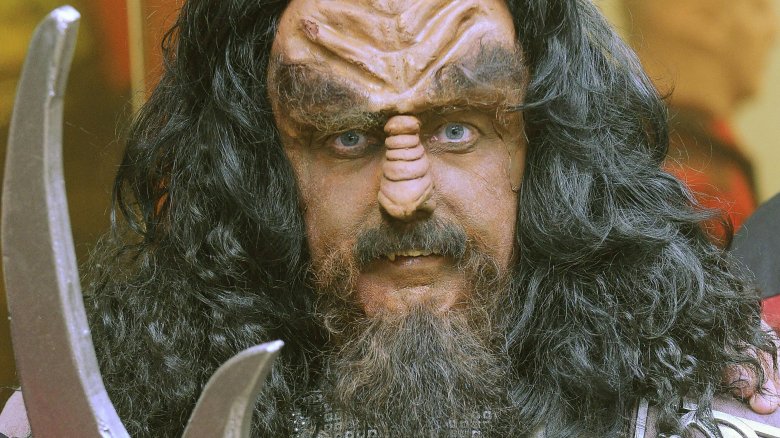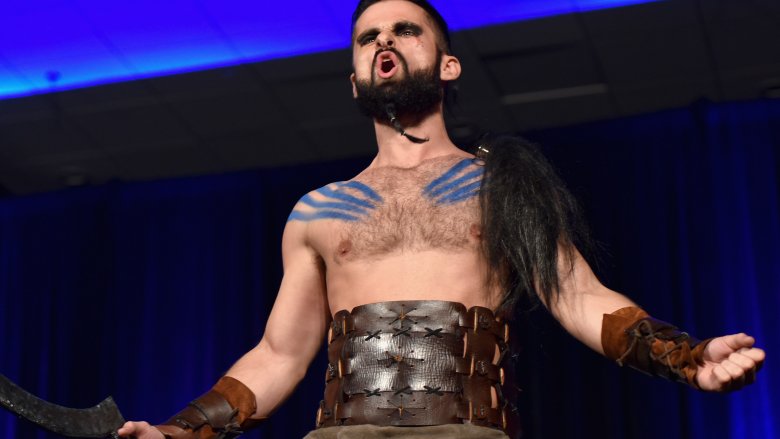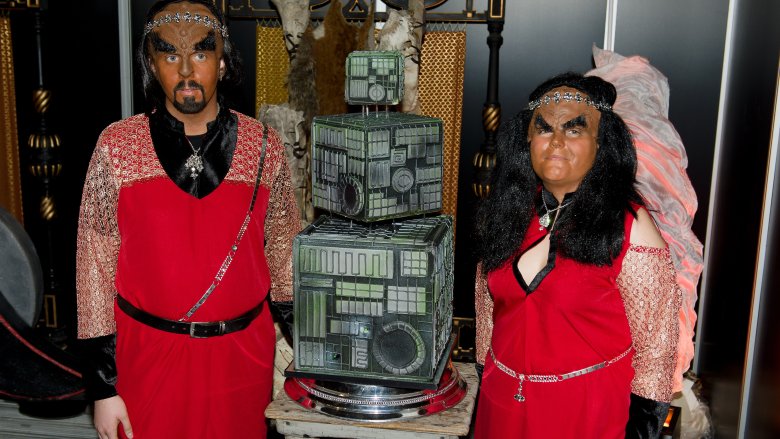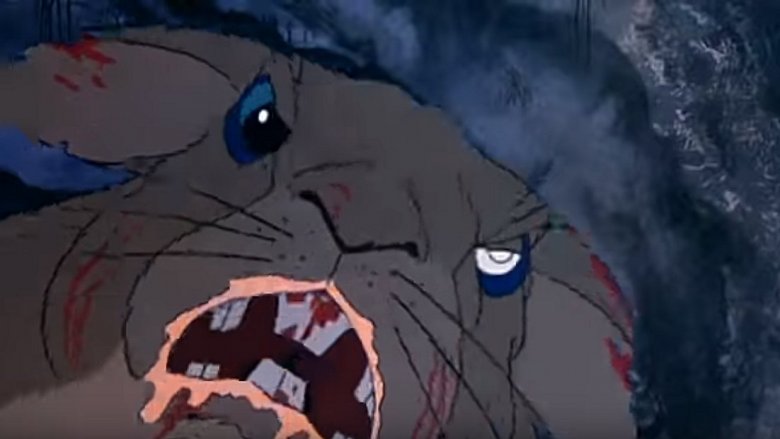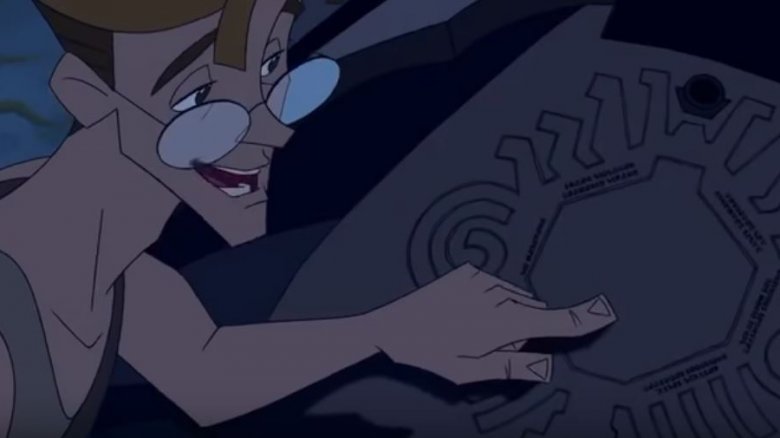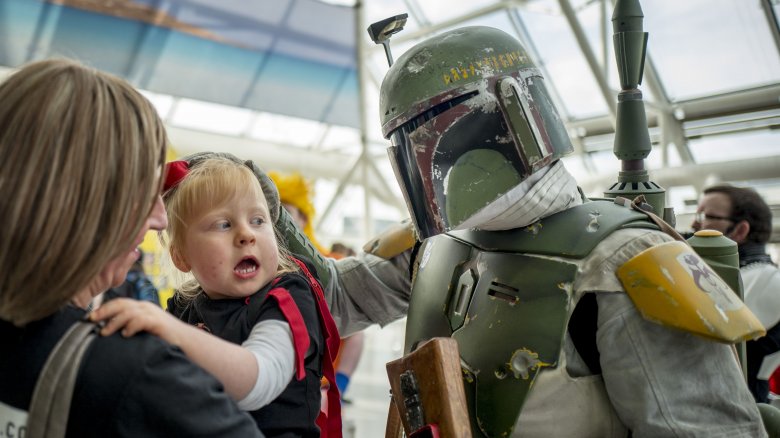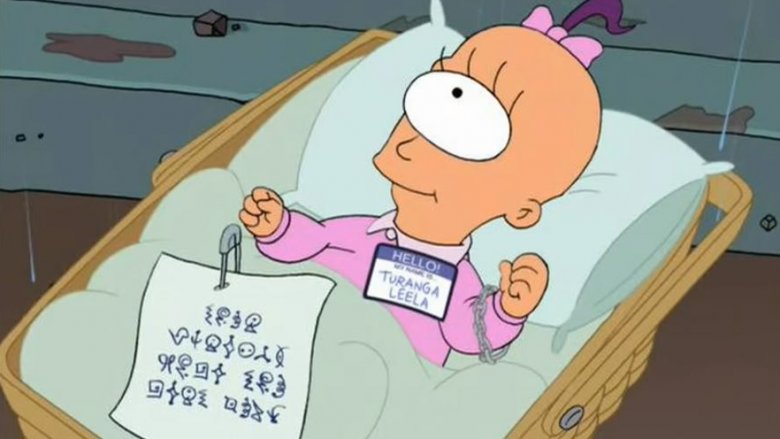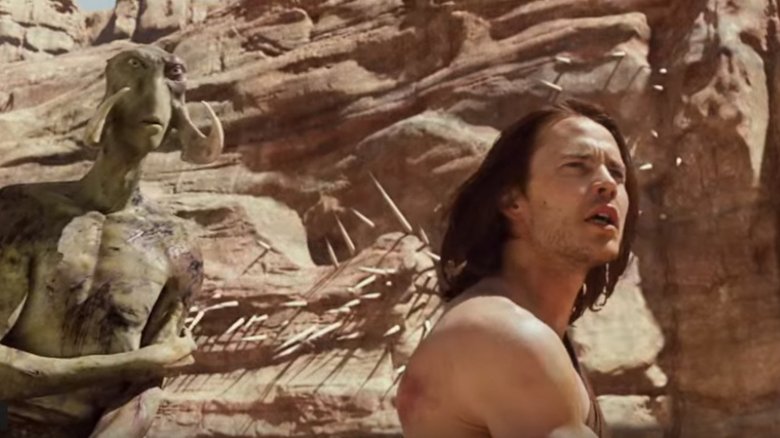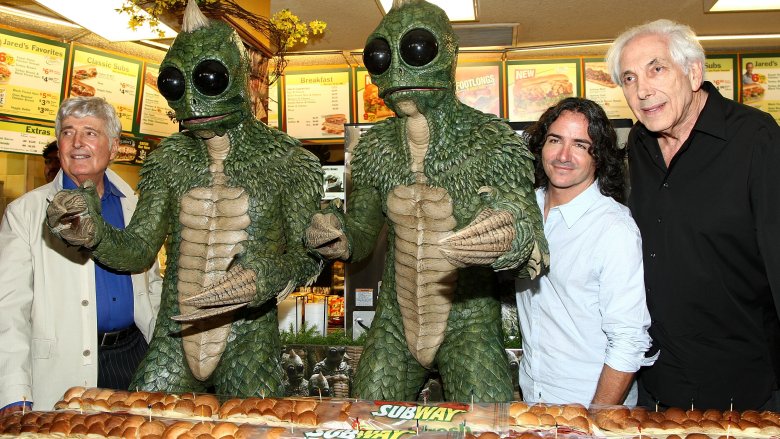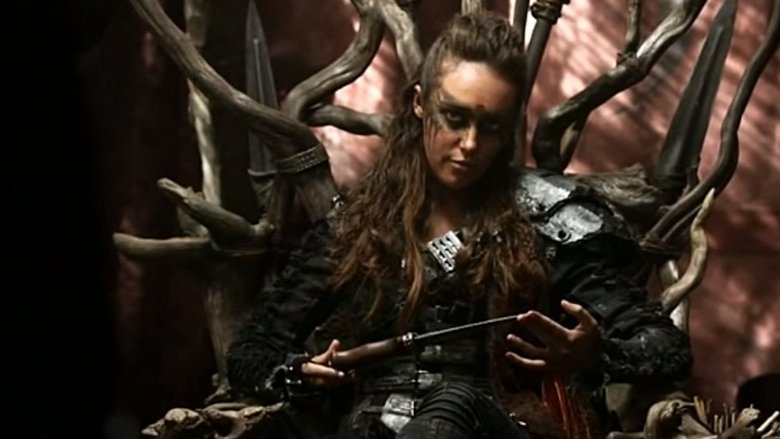Fictional Movie And TV Languages You Can Actually Learn To Speak
If Arrival taught the world anything, it's that whenever spaceships do finally touch down on Earth, linguists will save the world. Seriously, if they're not around, we'll be depending on some handy universal translator to drop out of the sky. No matter what sort of weird mumbles, beamed images, or telepathic messages the real little green men use for communication, it definitely won't be the sloppy, haphazard series of sounds we call English.
With that in mind, it's no surprise that real linguists have played a pretty huge role in sculpting the fictional languages of your favorite science fiction and fantasy worlds. For every badass Dothraki chant or Klingon speech that you've ever heard, there's been a hardworking linguist who spent years developing a real, complex language with its own grammar, slang, and unique metaphors. These constructed languages — called "conlangs," for short — are often so developed that if you have some time to kill, you can impress your next date with a newfound fluency in Barsoomian.
The language that sailed across the Narrow Sea
He might take a long time to finish books, but George R. R. Martin deserves some serious credit for creating an entire fictional world that millions of real people have become so invested in. One aspect of the Game of Thrones universe that Martin didn't create, though, is the Dothraki language. When A Song of Ice and Fire was first adapted to TV, Vulture reports, producers hired linguist David J. Peterson to take the isolated words and phrases that Martin made up, and to sculpt them into a language befitting the nomadic, horse-riding culture. As any fan knows, Dothraki culture isn't inclined toward censorship or euphemisms, and according to Mental Floss, the over 3,000 words that Peterson composed were written to suit that aggressive lifestyle: some everyday Dothraki phrases involve the ripping of throats, bleeding stars, and bleeding boars. You know, good ol' playground stuff. The Dothraki language also contains no phrase for "thank you," and really, can you imagine Khal Drogo thanking anyone for anything?
Peterson's work has been successful enough that in 2017, UC Berkeley announced that they'd be offering an entire course on Dothraki as a second language, according to The Independent. One thing that really bugs Peterson, though, is that apparently everyone pronounces Khaleesi wrong. It's supposed to be KHAH-LAY-see, but the producers liked the other way better, and overruled him. Hey, annoying quirks like that happen with natural languages, too.
Pandora speaks
If a bunch of blue humanoids lived in deep communion with nature, what sort of language would they speak? Director James Cameron didn't cut any corners when he developed the mega-blockbuster world of Avatar, and he assigned the daunting task of creating a Na'vi tongue to linguist Paul Frommer. Frommer and Cameron spent years crafting every piece of the complex language, according to NPR, perfecting it by having all the Avatar actors listen to recordings on their iPods, as Frommer stood on the sidelines and intervened anytime a term was mispronounced. The end result was a fascinatingly bizarre new conlang that, years later, can be learned as a second language by anyone so inclined, according to Fluent in 3 Months. Hopefully James Cameron has it all memorized by now, considering those eighteen million Avatar sequels he's working on.
Don't underestimate the challenge of learning to speak Na'vi, though. As The Telegraph points out, the bluest language of all features challenging ejectives (clicking sounds); ditches those familiar B, J, or SH sounds; and loads up on the Xs. If you're the sort of person who'd rather just learn the dirty words in the dictionary, the Na'vi term for butt is "tx," and moron is "skxawng," so there's a start.
Worf would approve
The undisputed champion of all conlangs is Klingon, the mother tongue of the most honorable aliens in Star Trek, which holds the Guinness World Record for most widely spoken fictional language of all time. Here in the 21st century, not only is there a Klingon Language Institute, but also a Klingon translation of Hamlet, and as if that wasn't amazing enough, The Financial Post reported in 2016 that a federal U.S. judge was asked to officially recognize Klingon as a real, authentic language, outside the reach of copyright laws (though sadly, the judge declined to rule on the matter).
No wonder the Klingons on Star Trek: Discovery don't speak to each other in some flimsy old Earth language anymore. Who needs English when you have tlhIngan Hol?
Weirdly enough, though, the development of Klingon as a real language is more recent than you'd think. As CNN explains, those original flat-headed Klingons that Kirk and Co. mingled with in the 1960s just spoke regular English, via the universal translator, and it wasn't until 1984 when Gene Roddenberry hired a linguist to turn Klingon into something more fleshed out. That linguist turned out to be Marc Okrand, who drafted up the guttural warrior language that science fiction fans love today. Okrand went on to write (and publish) an official Klingon Dictionary, which sold over 250,000 copies. Now there are some enthusiastic Trekkers.
Songs of the elves
Part of what makes the Lord of the Rings universe feel so real is the dazzling multitude of languages which J.R.R. Tolkien described in the books, spoken by everything from trees to goblins to dwarves. Of these languages, The Guardian says that the two which really hold up to scrutiny are the silvery tongues of the elves: Qenya and Sindarin.
Of the two, Sindarin is the spoken language used among the elves, while Qenya is the beautiful, artsy sound reserved for poetry, high speech, magic, weapon inscriptions, and other serious business. Qenya, which pulls from Old Norse, Welsh, Finnish, and Gaelic influences, is particularly celebrated by Middle Earth aficionados who, according to SyFy, have spent decades winding their way through the mystical linguistic caverns that Tolkien so carefully put together in order to create their own works. These fans are so dedicated that an actual Elvish Linguistic Fellowship (E.L.F.) exists, and it publishes three journals.
Hoppin' with the bunnies
If hearing the title Watership Down gives you nightmares of cute cartoon bunnies ripping each other into gory chunks, you're not alone. However, there's a lot more depth to Watership Down than the animated animal violence memes would have you believe, including the fact that author Richard Adams sculpted a rather fascinating rabbit language called Lapine.
What makes Lapine so clever is that it's designed based on real rabbit lifestyles, anatomies, and habits, rather than trying to force human ideas into bunny heads. For example, The Encyclopedia of Fictional and Fantastic Languages points out the Lapine phrase silflay, which means "going above ground to feed" — a short term for a more complex idea which wouldn't be much use to humans, linguistically, but is very relevant to the lifestyle of a certain long-eared, furry mammal. As The Guardian adds, the word tharn is used to describe the glassy-eyed, paralyzed state that rabbits fall into when they're scared, while hlao refers to small dips in the grass that collect water. There's no proper word for the number five, since rabbits have four toes. If this isn't enough to get you to reread the original book or rewatch the animated film, well, a new TV miniseries did premiere in 2018...
Listen to the fishes
In the DC Universe, Aquaman and his Atlantean brethren are usually depicted speaking English. But for Disney's oft-forgotten undersea adventure Atlantis: The Lost Empire, the Mouse House wanted to kick things up a notch. Since the film's protagonist is a linguist named Milo Thatch (voiced by Michael J. Fox), it's only fitting that they hired a real linguist to craft the ancient language of the Atlanteans, and the man for the job ended up being Klingon inventor Marc Okrand, according to The South Florida Sun Sentinel.
Since the plot of Atlantis: The Lost Empire involves lots of ruins and texts, Okrand had to create not only a spoken language, but also a written form with the help of John Emerson. The end result? As described in the film, Atlantean is like deconstructed Latin with Sumerian and Thessalonian dumped on top, and if you want to be like Milo, you can do your homework and learn it in real life.
Say goodnight, Jedi scum
Okay, first thing's first: while it might sound like everybody in Star Wars is speaking the Queen's English, in the Star Wars universe this language is just called Galactic Basic. Secondly, that rugged bounty hunter known as Boba Fett isn't just one dude in badass armor, but part of a warrior group known as the Mandalorians, who actually have their own language, called Mando'a.
If you're wondering where any of this is mentioned in the movies, well, it isn't really elaborated on much. As for the Mando'a language, it was invented not by George Lucas, or by a linguist, but by composer Jesse Harlin, according to Music on Film. Harlin did the score for the video game Star Wars Galaxies, and needed words for the lyrics of the Clone Army's anthem. Hey, if you can't find the right word, just make one up, right? Though Harlin got the ball rolling, true credit for turning Mando'a into a genuine conlang goes to Star Wars novelist Karen Traviss. With the premiere of the 2019 TV show The Mandalorian, hopefully Traviss and Harlin's hard work will finally get the attention it deserves.
The future is Alienese
Futurama is a cult classic, and part of the reason is because it's a series that rewards fans for paying attention, whether through time traveling plot twists or carefully built payoffs. Case in point? According to io9, backgrounds for the show's early episodes featured a coded alphabet called Alienese, invented by creators David X. Cohen and Matt Groening, where the 26 letters of the Roman alphabet were replaced by strange extraterrestrial characters. This would have provided a great opportunity to do inside jokes, but less than an hour after the show's premiere, fans figured the code out. Not such an "inside joke" if everyone knows it, right?
Not to be outdone, Cohen and Groening replaced the old Alienese with the bigger, better Alienese II. This time, rather than simply swapping out letters for other letters, translating a message in Alienese II requires doing math problems for every symbol. Yikes! That said, if arithmetic isn't your thing, there's now an online translator.
Sounds of the Barsoomians
In the classic 1912 science fiction novel A Princess of Mars by Edgar Rice Burroughs, a U.S. Civil War veteran named John Carter is transported to the red planet — called Barsoom by those living on it — and while there, he gets involved in Martian wars, politics, and romance. Even back in 2012, though, Burroughs didn't assume that Martians would speak English. Instead, he described them as speaking a language called Barsoomian, a foreign tongue so concise and easy that John Carter is able to learn the whole language in just a week.
This would propose a unique challenge to any filmmaker, no matter how experienced. When John Carter made the jump to the big screen in 2012, Disney hired Paul Frommer, the same guy who created the Na'vi language, to develop Barsoomian into a real language. In an interview with The Deadbolt, Frommer said that he used the 400-some words Burroughs had previously come up with to spin together a simple but thorough new conlang, relying primarily on word order to communicate ideas. One area he didn't work on, but found interesting, was that while the entire population of Barsoom speaks the same language, they are all supposed to have different written languages. Get to work, fans! After all, it should only take a week to learn it.
Game of Thrones gets flowery
Dothraki is definitely a cool language, but it isn't the only fully developed conlang populating George R. R. Martin's fantasy epic. There's also the Valyrian language family, created by David J. Peterson, according to Mental Floss. And yes, unlike Dothraki, you can say "thank you" in Valyrian.
In Westeros, so-called "High Valyrian" is a learned language spoken only by the elite — think of it as snobby Valyrian, if you will — while "Low Valyrian" is a common tongue that evolved in various regions of the fictional world. Some of the more interesting aspects of Valyrian is that it classifies people according to four genders, instead of just two, and instead of defining objects by sex a la many real languages, organizes them according to whether they are lunar, solar, terrestrial, or aquatic. For example, your beer is aquatic, but your hand is solar, and your father is lunar.
See? These conlangs are no joke! Another fun fact: Daenerys Targaryen, the world-traveling conqueror and self-proclaimed "breaker of chains," sometimes speaks in her own form of Valyrian that blends low and high together, for political reasons.
Land of the lost (language)
Way back before Star Trek turned Klingon into a real language, a goofy kid's TV show named Land of the Lost was trying to teach kids how to speak the fictional Paku language. In case you didn't watch the original show (or check out the slapstick 2009 Will Ferrell spoof), Land of the Lost features an everyday family who travel to an alternate reality where dinosaurs still dominate the earth alongside creepy reptoid Sleestaks, which would fit easily into any ridiculous Illuminati conspiracy theory.
The series also featured a species of intelligent primates called the Pakuni, who spoke a language called Paku, created by linguist Victoria Fromkin. Here's the cool thing: the reason that the Pakuni spoke Paku was so that the series would have an educational component for younger viewers, allowing them to learn the language alongside the characters. Like an alternate reality Sesame Street, see? Unfortunately, the show was canceled after only two seasons, but the 200 Pakuni words created for Land of the Lost nonetheless deserve credit as the first genuine fictional language in TV history.
Clockwork goloss
Even if you've only seen Stanley Kubrick's movie version of A Clockwork Orange, you should have some passing familiarity with Nadsat, the futuristic slang that the characters use, particularly in the early sections. If you've read the book, though, you know that Nadsat is a fully developed language with many intricacies. Anyone who has ever cracked open the first chapter very quickly became familiar with the book's glossary, because translating that prose is definitely no joke.
The reason that Nadsat is so well realized is that author Anthony Burgess was (what else?) a linguist. According to From Elvish to Klingon: Exploring Invented Languages, Burgess wanted his story to stand the test of time, and he knew that using contemporary teen slang would date it within a few years. So, instead, he crafted a brand new slang language by pairing childish terms with reworked Slavic and Roma phrases, according to Babbel Magazine, resulting in the perfectly messy, chaotic Nadsat that fans have, in the years since, recorded into unofficial Nadsat dictionaries. Real horrorshow, eh?
Stuck on a post-apocalyptic Earth? Make a new language
When the science fiction TV series The 100 wanted to depict "Grounders," the stranded remnants of a human population left behind on a post-apocalyptic Earth, they figured that these people's day-to-day language would probably have evolved into something highly different from the English we know today. So, the producers did the sensible thing, according to The Atlantic: they hired David Peterson, the guy who created the various tongues on Game of Thrones, to put together a cool new language called Trigadasleng.
Writing about his futuristic language on Tumblr, Peterson explained that Trigadasleng is intended to be a form of creole English that has just evolved in a very different direction, to the point of being a new language entirely. However, if you're looking to learn Trigadasleng, don't go stumbling in blindly — many of the differences are subtle, meanings are changed, and pronunciations aren't always what you'd think they are. Pay close attention!
